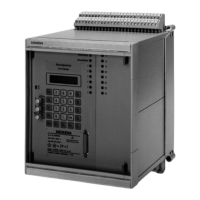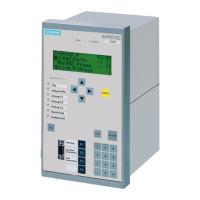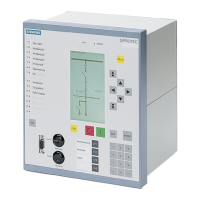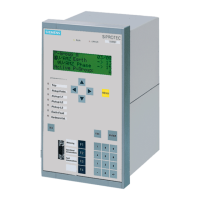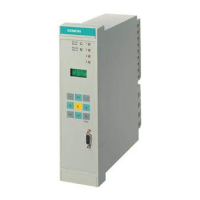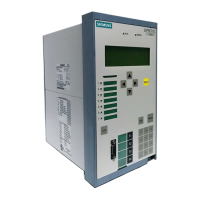Functions
6-172 7SA6 Manual
C53000-G1176-C156-2
line onto a fault usually causes a large fault current. It is important to avoid that the
selected stage picks up in a transient way when energizing the line.
Inverse Time
Overcurrent Stages
IP, 3I0P
with IEC
In the case of the inverse time overcurrent stages, various characteristics can be se-
lected, depending on the version of the device and the configuration (Section 5.1, ad-
dress
126). For the IEC–curves (address 126 Back-Up O/C = TOC IEC)thefollow-
ingareavailableinaddress
2660 IEC Curve:
Inverse (normal inverse, Type A according to IEC 60255–3),
Very inverse (very inverse, Type B according to IEC 60255–3),
Extremely inverse (extremely inverse, Type C according to IEC 60255–3), and
LongTimeInverse (longtime, Type B according to IEC 60255–3).
The curves and equations that the curves are based on, are shown in the technical
data (Section 10.5, Figure 10-1).
For the setting of the current thresholds
Ip> (address 2640)and3I0p PICKUP (ad-
dress
2650) the same considerations as for the overcurrent stages of the definite time
protection (see above) apply. In this case it must be noted that a safety margin be-
tween the pick-up threshold and the set value has already been incorporated. Pick-up
only occurs at a current which is approximately 10 % above the set value.
The above example shows that the maximum expected operating current may directly
be applied as setting here:
primary: Set value Ip> = 630 A,
secondary: SetvalueIp>=5.25A,i.e.(630A/600A)·5A.
The time multiplier setting
T Ip Time Dial (address 2642) is derived from the grad-
ing plan applicable to the network. If implemented as emergency overcurrent protec-
tion, shorter tripping times are advisable (one grading time margin above the fast trip-
ping stage), as this function is only activated in the case of the loss of the
local meas-
ured voltage.
The time multiplier setting
T 3I0p TimeDial (address 2652) can usually be set
smaller according to a separate earth fault grading plan.
In addition to the current dependant time delay an additional constant time length de-
lay can be set if required. The setting
T Ip Add (address 2646 for phase currents)
and
T 3I0p Add (address 2656 forearthcurrents)areinadditiontothetimedelays
resulting from the set curves.
The setting parameter
I(3I0)p Tele/BI (address 2670) determines if it is possible
to use the binary input “
>O/C InstTRIP”(F.No.7110) to bypass the trip delays T
Ip Time Dial
(address 2642) including the additional time T Ip Add (address
2646)andT 3I0p TimeDial (address 2652) including the additional time T 3I0p
Add
(address 2656). The binary input (if it is assigned) is common to all stages of the
overcurrent protection. With the setting
I(3I0)p Tele/BI = Yes it is therefore de-
termined that the I
P
–stage trips without delay following pick-up if an operate signal is
present at the binary input; with the setting
I(3I0)p Tele/BI = No the set time de-
lays always come into effect.
IftheIp-stageistotripwhenswitchingthelineontoafaultwithoutorwithashortde-
lay,
SOTF Time DELAY (address 2680, see above and refer to Sub-section “Gener-
al”), the parameter
I(3I0)p SOTF (address 2671)issettoYes. We recommend,
however, not to choose the sensitive stage for the switch on to fault function as ener-
gizing of the line on to a fault should cause a large fault current. It is important to avoid
that the selected stage picks up in a transient way during line energization.

